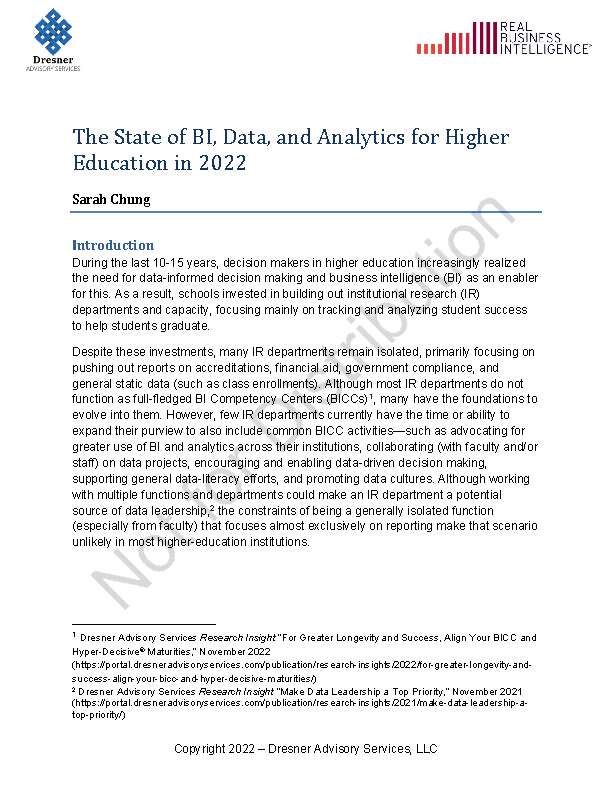
During the last 10-15 years, decision makers in higher education increasingly realized the need for data-informed decision making and business intelligence (BI) as an enabler for this. As a result, schools invested in building out institutional research (IR) departments and capacity, focusing mainly on tracking and analyzing student success to help students graduate.
Despite these investments, many IR departments remain isolated, primarily focusing on pushing out reports on accreditations, financial aid, government compliance, and general static data (such as class enrollments). Although most IR departments do not function as full-fledged BI Competency Centers (BICCs), many have the foundations to evolve into them. However, few IR departments currently have the time or ability to expand their purview to also include common BICC activities—such as advocating for greater use of BI and analytics across their institutions, collaborating (with faculty and/or staff) on data projects, encouraging and enabling data-driven decision making, supporting general data-literacy efforts, and promoting data cultures. Although working with multiple functions and departments could make an IR department a potential source of data leadership, the constraints of being a generally isolated function (especially from faculty) that focuses almost exclusively on reporting make that scenario unlikely in most higher-education institutions.
In addition to lower levels of data leadership, many higher-education institutions also face a pending challenge from lower enrollments. Lower birth rates have hit the incoming freshman class in 2022, and will continue to do so for the foreseeable future. Also, in the aftermath of the COVID-19 pandemic, on-campus student presence—and resulting revenue associated with high-margin services such as room and board—dropped as shutdowns resulted and remote learning became the norm. Lower revenue in turn will continue to negatively impact budgets, including those for BI and analytics.
These challenges escalate the need for much more data-driven decision making throughout higher-education institutions—in support of academic programs, as well as overall operations. For example, although faculty reviews, tenure, and promotion are highly data-driven, the data tend not to be readily available for faculty to compile. Many faculty and operations staff remain data starved, and higher-education institutions tend to lag on technology adoption—which our data on lower BI penetration and data-access rates (compared to the overall survey sample) reflect.
Many higher-education institutions are at a critical juncture where opportunity exists to increase the institution’s maturity within the Dresner Advisory Services Hyper-Decisive® Maturity Model (HDMM). The addition of formal data leadership can play an important role in this journey by instilling a data-driven culture, improving access to data, and implementing and upgrading processes and systems that increase the frequency of data-driven decision making. Promisingly, institutional upper management seems to recognize and support the greater need for data-driven decision-making in student success and retention, as well as institutional operations.
You do not have permission to access this document. Make sure you are logged in and/or please contact Danielle with further questions.